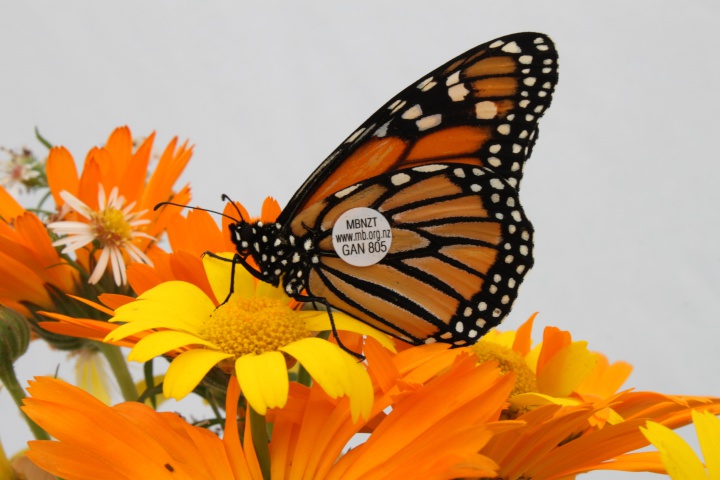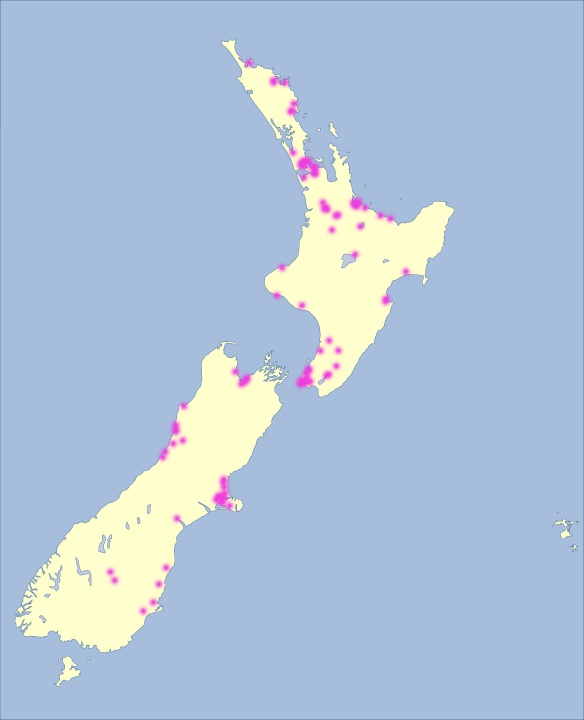Tagging Monarchs
Tagging Monarchs
by Joan Fairhall, joan@monarch.org.nz
Are you aware of the nationwide monarch tagging programme that’s been running for the past 12 years?

It’s a citizen science initiative run by the Moths and Butterflies of New Zealand Trust. Tagging is starting around now, when monarch butterflies are more likely to go into diapause. That means that although they are sexually mature they will not breed until the spring.
Monarchs originate from North America, where every autumn more than 250 million Monarchs leave southern Canada and northern United States and journey south 5,000 kilometres to their overwintering roosts in the Mexican mountains. The USA tagging programme shows that numbers are declining, and scientists are worried.
Here in NZ monarchs are classed as ‘native’ as they made their own way here (not ‘introduced’, as was the annoying cabbage white). But where do they overwinter? How many sites are there? Why does it matter?
Canary in the coal mine
As Monarchs are relatively common, easily seen and not afraid of humans they are ideal as a biodiversity ‘indicator species’ – telling us what is happening to our environment. By analysing data obtained through tagging, scientists can assess what is happening to our monarchs and by extension measure changes to our environment that affect other insects too. If insects are compromised, our very survival will be at risk.
Also, we can try to ensure
overwintering sites are not destroyed. This is one way in
which citizen scientists (that’s you!) can participate in
a real science project.
The aim is to find out about the Monarch’s winter behaviour by tagging the overwintering generation, not those butterflies that emerged through spring and summer. Tags are provided free by the Trust, and it takes only a little time and effort to apply a tag and log the details online. Or, when you find a weary tagged butterfly in winter or early spring, to go online and report where you found it.
Each tag weighs 0.006g which is 1.2% of the mass of a butterfly. Attaching a tag makes the monarch about as lopsided as you are when you put your keys or cellphone in your pocket!
Let’s put our monarchs on the research map. To find out more and request tags go to www.monarch.org.nz and click on the ‘Research’ tag.

Some things it’s
cool to know about monarchs
A female monarch can
smell a swan plant from two kilometres away.
Male monarchs have an oval black scent pouch on their lower wings. Females’ wings have thicker black veins.
A female monarch lays on average 300–400 eggs. One is recorded to have laid over 1,000!
A caterpillar grows from a tiny egg to ready-to-pupate in just three weeks, increasing in size by about 3,000 times. The larvae shed their skin five times as they grow.
Pumpkin is not good for young caterpillars – they can become deformed. Stick with the swan plant!
Masses of monarchs cluster together on podocarp trees to overwinter. They won’t mate until the following spring. Some NZ sites are known, but there must be hundreds that are not known.


 Gordon Campbell: On Winston Peters’ Battle Against The Phantom Legions Of The Woke
Gordon Campbell: On Winston Peters’ Battle Against The Phantom Legions Of The Woke ActionStation: Economists, Campaign Groups Hit Out At PPP’s Labelling Them ‘Ideological, Reckless’
ActionStation: Economists, Campaign Groups Hit Out At PPP’s Labelling Them ‘Ideological, Reckless’ Greenpeace: Luxon’s Investment Claims Undermined By Breaches Of Free Trade Agreements
Greenpeace: Luxon’s Investment Claims Undermined By Breaches Of Free Trade Agreements Living Wage Aotearoa: Government Cleaners, Security Guards, And Caterers Counting On NZ First
Living Wage Aotearoa: Government Cleaners, Security Guards, And Caterers Counting On NZ First  Environmental Defence Society: Infrastructure Summit Should Prioritise Environmental Outcomes
Environmental Defence Society: Infrastructure Summit Should Prioritise Environmental Outcomes Green Party: Just Six Government MPs Needed To Pass Unlawful Occupation Of Palestine Sanctions Bill
Green Party: Just Six Government MPs Needed To Pass Unlawful Occupation Of Palestine Sanctions Bill Ngāti Manuhiri Settlement Trust: Iwi Welcomes Progress On Northland Expressway
Ngāti Manuhiri Settlement Trust: Iwi Welcomes Progress On Northland Expressway


